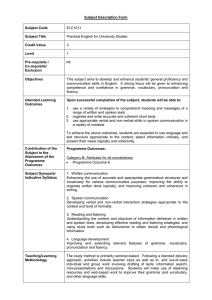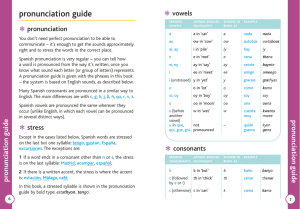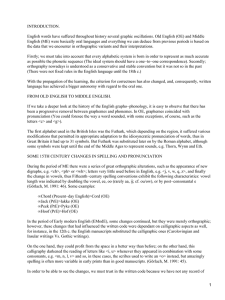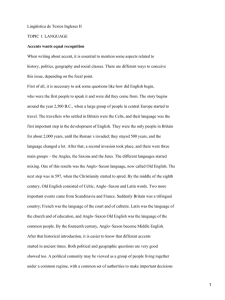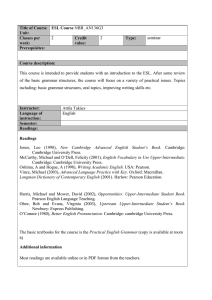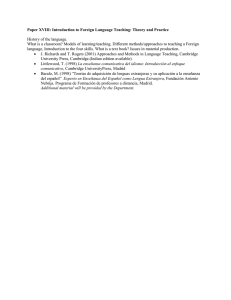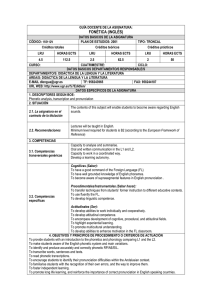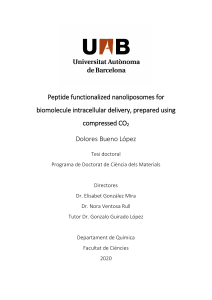1 3. Speaking - Universidad de Jaén
Anuncio
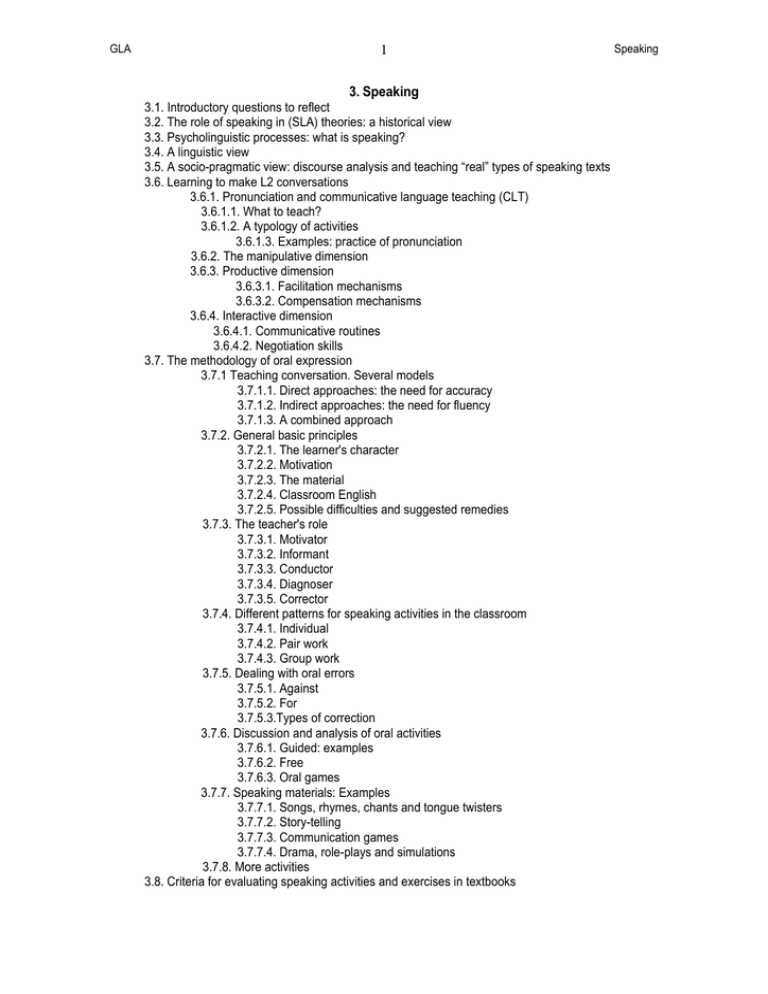
GLA 1 3. Speaking 3.1. Introductory questions to reflect 3.2. The role of speaking in (SLA) theories: a historical view 3.3. Psycholinguistic processes: what is speaking? 3.4. A linguistic view 3.5. A socio-pragmatic view: discourse analysis and teaching “real” types of speaking texts 3.6. Learning to make L2 conversations 3.6.1. Pronunciation and communicative language teaching (CLT) 3.6.1.1. What to teach? 3.6.1.2. A typology of activities 3.6.1.3. Examples: practice of pronunciation 3.6.2. The manipulative dimension 3.6.3. Productive dimension 3.6.3.1. Facilitation mechanisms 3.6.3.2. Compensation mechanisms 3.6.4. Interactive dimension 3.6.4.1. Communicative routines 3.6.4.2. Negotiation skills 3.7. The methodology of oral expression 3.7.1 Teaching conversation. Several models 3.7.1.1. Direct approaches: the need for accuracy 3.7.1.2. Indirect approaches: the need for fluency 3.7.1.3. A combined approach 3.7.2. General basic principles 3.7.2.1. The learner's character 3.7.2.2. Motivation 3.7.2.3. The material 3.7.2.4. Classroom English 3.7.2.5. Possible difficulties and suggested remedies 3.7.3. The teacher's role 3.7.3.1. Motivator 3.7.3.2. Informant 3.7.3.3. Conductor 3.7.3.4. Diagnoser 3.7.3.5. Corrector 3.7.4. Different patterns for speaking activities in the classroom 3.7.4.1. Individual 3.7.4.2. Pair work 3.7.4.3. Group work 3.7.5. Dealing with oral errors 3.7.5.1. Against 3.7.5.2. For 3.7.5.3.Types of correction 3.7.6. Discussion and analysis of oral activities 3.7.6.1. Guided: examples 3.7.6.2. Free 3.7.6.3. Oral games 3.7.7. Speaking materials: Examples 3.7.7.1. Songs, rhymes, chants and tongue twisters 3.7.7.2. Story-telling 3.7.7.3. Communication games 3.7.7.4. Drama, role-plays and simulations 3.7.8. More activities 3.8. Criteria for evaluating speaking activities and exercises in textbooks Speaking GLA 2 Speaking References SET READINGS Bueno González, A. 1999. "El registro oral: comprensión y expresión" in Salaberri Ramiro, S. (ed.). Lingüística Aplicada a la enseñanza de lenguas extranjeras. Almería: Servicio de Publicaciones de la Universidad. pp. 334-356. Harmer, J. 1998. How to Teach English. Harlow: Longman. Chapter 9. Tejada Molina, G. & J.M. Nieto García. 1996. "Oral communication" in McLaren, N. & D. Madrid (eds.). A Handbook for TEFL. Alcoy: Marfil. Chapter 9. COMPLEMENTARY BIBLIOGRAPHY BASIC BIBLIOGRAPHY Madrid, D. & N. McLaren. 1995. Didactic Procedures for TEFL. Valladolid: La Calesa. Chap. 3: 60-90. Ur, P. 1996. A Course in Language Teaching. Cambridge: Cambridge University Press. Module 4. Module 9. SPECIFIC BIBLIOGRAPHY THEORY Burns, A. 1998. “Teaching speaking” Annual Review of Applied Linguistics, 18: 102-123. Bygate, M.1987. Speaking. Oxford: Oxford University Press. Bygate, M. 1998. “Theoretical perspectives on speaking” Annual Review of Applied Linguistics, 18: 20-42. Bygate, M. 2001. “Speaking”. In R. Carter & D. Nunan (eds.) The Cambridge Guide to Teaching English to Speakers of Other Languages. Cambridge: Cambridge University Press. Chap. 2: 14-20. Doff, A. 1988. Teach English. Cambridge: Cambridge University Press. Chap.: 10: 112-123; Chap. 18: 208-220; Chap. 20: 231-240. Cameron, L. 2001. Teaching Languages to Young Learners. Cambridge: Cambridge University Press. Chap. 3: 36-70. Richards, J. 1990. The Language Teaching Matrix. Cambridge: Cambridge University Press. Chap. 4. 6786. Scarcella, R. & R. Oxford. 1992. The Tapestry of Language Learning. Massachusetts: Heinle Publishers. 153-168. Seidlhofer, B. 2001. “Pronunciation”. In R. Carter & D. Nunan (eds.) The Cambridge Guide to Teaching English to Speakers of Other Languages. Cambridge: Cambridge University Press. Chap. 8: 5665. Swain, M. 1995. “Three functions of output in second language learning”. In G. Cook & B. Seidhofer (eds.) Principles and Practice in the Study of Language. Oxford: Oxford University Press. 125-144. White, L. 1987. “Against comprehensible input: The input hypothesis and the development of second language competence” Applied Linguistics, 8: 95-110. PRACTICE Dangerfield, L. 1985a. “Role-play”. In A. Matthews, M. Spratt & L. Dangerfield (eds.) At the Chalkface. Bath: Edward Arnold. 115-117. Gower, R, 1985. “Structured conversations”. In A. Matthews, M. Spratt & L. Dangerfield (eds.) At the Chalkface. Bath: Edward Arnold. 30-33. Klippel, F. 1984. Keep talking. Cambridge: Cambridge University Press. Matthews, A. & C. Read. 1985, “Information-gap activities for oral/aural practice”. In A. Matthews, M. Spratt & L. Dangerfield (eds.) At the Chalkface. Bath: Edward Arnold. 24-27. Spratt, M. 1985. “Discourse chains”. In A. Matthews, M. Spratt & L. Dangerfield (eds.) At the Chalkface. Bath: Edward Arnold. 28-29. GLA 3 Speaking 3. SPEAKING 3.1. Introductory question to reflect Is there a silent period in which learners should not be prompted to speak? 3.2. The role of speaking in (SLA) theories: a historical view 3.2.1. No role 3.2.1.1. Grammar translation approaches 3.2.1.2. No technology: tape-recording 3.2.1.3. Confusion between speaking and pronunciation, reading aloud, drilling… 3.2.2. Behaviourist accounts: the importance of oral languages. Speaking as repetition and habit formation 3.2.3. Mentalist accounts and the silent period 3.2.3.1. Speaking as hypothesis testing 3.2.3.2. Creative processes of rule formation 3.2.4. Interactional accounts: White’s (1987) and Swain’s hypotheses (1995). The role for output 3.2.5. Communicative approach: notions, functions and a focus on the learner 3.2.5.1. Language and meaning 3.2.5.2. A social context for language features: speech acts and functions 3.2.6. Skills-based models: oral L2 use within task-based approaches 3.2.6.1. Conversational analysis 3.2.6.2. Discourse analysis 3.2.6.3. Strategic work 3.3. Psycholinguistic processes: what is speaking? 3.3.1. General processes: Levelt’s model (1989) 3.3.1.1. Creating a message: conceptualisation, formulation and articulation 3.3.1.2. Requirements: restructuring, automation and overt or covert monitoring 3.3.1.3. The core of speech production: lexical patterns (words and chunks) 3.3.2. Second language production processes. Some fundamental differences 3.3.2.1. Lexical access 3.3.2.2. Pausing 3.3.2.3. Strategic use: compensatory use of communication strategies 3.3.2.4. Selection and combination processes 3.3.3. Conditions on speech production: factors influencing speaking 3.3.3.1. Fluency, accuracy and complexity of speech: attention constraints 3.3.3.2. Capacity and availability of working memory 3.3.3.3. Task load: demand, arousal and feedback 3.3.3.4. Communicative stress 3.3.3.4.1. Time pressure 3.3.3.4.2. Processing demands 3.3.3.4.3. Number of participants and length of texts used 3.3.3.4.4. Stakes: a light-hearted affair versus a pre-exam activity 3.3.3.4.5. Opportunity for control 3.3.3.5. Code familiarity and predictability 3.3.3.5.1. Availability of vocabulary 3.3.3.5.2. Structural difficulties 3.3.3.6. Learners’ personality and rate of learners per class 3.3.3.7. Physiological difficulties, muscular practice and pronunciation differences between languages 3.3.3.8. Sufficient practice: pair work and group work 3.3.3.8. Oral examinations 3.3.4. How does acquisition of speaking take place: processes of oral development GLA 4 Speaking 3.3.4.1. From meaning to form 3.3.4.1. Memory-oriented learners. From unanalysed chunks to analysis Top-down approach 3.3.4.2. Analytic learners. Exploring combinatorial possibilities Bottom-up approach 3.4. A linguistic view 3.4.1. Differences between spoken and written language 3.4.1.1. Process-based differences 3.4.1.1.1. On-line processing conditions 3.4.1.1.2. Reciprocity conditions 3.4.1.1.3. Predictability 3.4.1.2. Product-based differences (see again Mathews’ example, 1985: 61) 3.4.1.2.1. Syntax: dislocations, fragmentations, clausal or phrasal units 3.4.1.2.2. Density 3.4.1.2.3. Vocabulary usage: non-specific words 3.4.1.2.4. Use of formulaic language 3.4.1.2.5. Strategic phenomena: hesitations, pauses, errors, self-correction… 3.4.1.2.6. Frequency of certain patterns: the continuum between spoken and written language 3.5. A socio-pragmatic view: discourse analysis and teaching “real” types of speaking texts 3.5.1. A typology of spoken interactions 3.5.1.1. Conversations 3.5.1.1.1. Casual 3.5.1.1.2. Formal 3.5.1.2. Encounters 3.5.1.2.1. Factual 3.5.1.2.2. Transactional 3.5.2. Discourse strategies 3.5.2.1. Identification and analysis of different genres, conversational contributions and culturally-specific scripts and situations 3.5.2.2. Cross-cultural comparisons of genres, turn-taking and speech acts GLA 5 Speaking 3.5.3. Communication strategies: fostering their use? 3.5.3.1. Compensatory strategies: achievement versus reduction strategies 3.5.3.2. L2 based strategies Tarone’s classification (1981) Paraphrase Transfer/borrowing Avoidance (form or message) Mime Appeal for assistance Other strategies Risk-taking Elaboration Use of formulas Self-correction Invention of words: foreignizing Code-switch Use of fillers, pauses, etc. 3.6. Learning to make L2 conversations The importance of pronunciation Since it concerns the oral register, attention to phonological aspects is paramount here, especially in the case of English, where spelling and pronunciation do not coincide. This is evidently an added difficulty in the same way as spelling is for writing. We can devise specific speaking activities which concentrate their attention on pronunciation, such as "listen and repeat" or "reading aloud", where other skills are also integrated. 3.6.1. Pronunciation and communicative language teaching (CLT) 3.6.1.1. What to teach? 3.6.1.1.1. The question of Received Pronunciation (R.P.), target norms and intelligibility 3.6.1.1.2. Pronunciation errors, difficulties and problems 3.6.1.2. A typology of activities Mechanical production: listen and repeat drills (see Getting on, & Handout) ; discrimination practice with visual support; meaning contrasts with pictures; identification of sounds, stress and intonation with tongue twisters, rhymes, poetry, songs dialogues and chants; body movements (i.e. clapping, walking, snapping fingers or dancing) following intonation, stress or pausing; learning by heart of sentences, rhymes or chants; reading aloud. GLA Speaking 6 3.6.1.3. Examples: practice of pronunciation Five little elephants Five Little Elephants • • • • Five little elephants • • • Standing in a row • • • Five little trunks • • • Waving hello • • • • “Oh” said an elephant • • • “Time to go” Four little elephants… Phillips (1993:109) The Hokey Cokey (Aristotelous, 1980: 15) GLA 7 Speaking 3.6.2. The manipulative dimension Drills: the mechanics of speaking Learners have to become familiar with the mechanics of oral speech. Repetition can be crucial here, as we suggested in the previous section. In addition, some specific exercises, called "drills" can be devised. Drills are systematic (sometimes highly mechanical) speaking activities usually used to practise grammatical structures, sometimes vocabulary and always intonation. Although useful in order to practise some formal aspects in English, they present some drawbacks teachers should bear in mind. 3.6.3. Productive dimension It is evident that the way in which oral speech is organized is different from the way in which writing is, especially because of the time factor. This is the reason why the speaker needs to develop some strategies of facilitation and mechanisms of compensation for the difficulties that may arise. 3.6.3.1. Facilitation mechanisms (see Bygate 1987: 15 ff): • Simplifying structure • Ellipsis • Using formulaic expressions • Use of fillers, pauses and hesitation devices 3.6.3.2. Compensation mechanisms More often than not the speaker can alter what s/he has said, thus using what we can call compensation mechanisms. In oral speech corrections are tolerated and considered as inevitable, which does not happen in the same way with writing. Similarly, speakers reformulate what they say to make themselves sure the listener has understood the message. We have to be aware of the pedagogical implications of the aforementioned mechanisms and see speaking as characterized by the following features (and, consequently, admit them): . adjustments: . self-correction . false starts . rephrasings . hesitations . circumlocutions . ellipsis and parataxis . repetition . formulaic expressions GLA 8 Speaking 3.6.4. Interactive dimension 3.6.4.1. Communicative routines • • Information routines o Expository routines: Narrative Description Instruction Comparison o Evaluation routines: Explanation Justification Prediction Decision and preferences Situational / Interactive routines (according to different situations): "Service encounters" Telephone conversations Interview situations Casual encounters Conversations at parties Conversations around the table Lessons Radio / TV interviews 3.6.4.2. Negotiation skills Negotiation of meaning: • Face to face • The way participants signal understanding during exchange • Direct negotiation Management of interaction: • Who is going to speak next • What about • Without a chairperson 3.7. The methodology of oral expression 3.7.1 Teaching conversation. Several models 3.7.1.1. Direct approaches: the need for accuracy 3.7.1.1.1. Language awareness and consciousness-raising practice 3.7.1.1.2. A teaching model: presentation, practice and production in context 3.7.1.2. Indirect approaches: the need for fluency 3.7.1.2.1. A focus on tasks and on the negotiation of meaning 3.7.1.2.1.1. Information gap 3.7.1.2.1.2. Choice 3.7.1.2.1.3. Feedback 3.7.1.2.2. A teaching model: communication, presentation of language, and drilling 3.7.1.3. A combined approach Input phase, rehearsal phase and performance: a sequence of repetition and recycling GLA 9 Speaking 3.7.2. General basic principles 3.7.2.1. The learner's character 3.7.2.2. Motivation 3.7.2.3. The material 3.7.2.4. Classroom English 3.7.2.5. Possible difficulties and suggested remedies . Provide them with interesting material. . Try and create a relaxing atmosphere in class, making the setting as natural as possible. . Use pair-work. . Pay more attention to fluency than to accuracy. . Present activities that involve information gap and negotiation of meaning in order to create the communicative need. . Familiarize students with conversational formulae and fillers. . Remember that the speaking skill is better exploited if preceded by listening or reading and followed by writing. Anyway, some concrete problems may still persist, such as large classes, acoustic problems or the insecurity of the teacher. 3.7.3. The teacher's role 3.7.3.1. Motivator 3.7.3.2. Informant 3.7.3.3. Conductor 3.7.3.4. Diagnoser 3.7.3.5. Corrector 3.7.4. Different patterns for speaking activities in the classroom 3.7.4.1. Individual 3.7.4.2. Pair work 3.7.4.3. Group work GLA 10 Speaking 3.7.5. Dealing with oral errors Error correction (Vale and Feunteun, 1995: 198) 3.7.5.1. Against 3.7.5.1.1. The silent period versus testing speaking. 3.7.5.1.2. The difficulty of designing oral exams 3.7.5.2. For 3.7.5.2.1. The Backwash (Ur, 1996: 35, 134) effect. 3.7.5.2.2. Evaluating what we teach in the way we teach it 3.7.5.2.3. A scale of oral testing criteria (Ur, 1996:135) 3.7.5.3.Types of correction: 3.7.5.3.1. Immediate versus later correction 3.7.5.3.2. Errors as sources of presentation of new material 3.7.5.3.3. Error correction as remedial work 3.7.5.3.4. Correcting oral work. Alternatives: recasts, expansions, symbols and gestures GLA 11 Speaking Correcting errors: several options - Direct correction: the problem is that continuous interruptions may be discouraging, demotivating and even rude. - Silent correction: the idea is to offer some help for self-correction by means of gestures of surprise, repetition of the wrong sentence or word, emphasis on the mistake through intonation, incomplete sentences, asking him/her, etc. - Delay correction: correction takes place after the oral activity; the most advantageous point is that it does not interfere with communication and, therefore, encourages students to speak fluently; it is essential for the teacher to find some system for noting errors down for correction at a later stage. Some possibilities are the following: i) Tape-recording the activity ii) Relying on the teacher's memory iii) Noting down the errors. In the case of an individual oral interview we suggest the use of a grid where you take down details about the performance. The sections could be pronunciation, fluency, structures and meaning. If the interview is not very long it is not difficult to note things down once the student has left the room and before another comes in. (see Harmer 1998: 94, "How should teachers correct speaking?") 3.7.6. Discussion and analysis of oral activities 3.7.6.1. Guided: examples - Information-gap exercises: students work in pairs; a communicative need is created because the two students in each pair are given different information -see Doff, Activity 3, Unit 18). - Split dialogues: one half of the dialogue is given and the student contributes the other. - Reading aloud: apart from other advantages, it presents the positive point of connecting spelling and pronunciation and it allows students to speak longer stretches of English without problems of vocabulary, structure and memory; we must admit that it is not really a natural activity, it takes a lot of time, really only one student is active and it is difficult to check if they understand; more often than not it becomes a pronunciation exercise. - Answering questions orally: we should not ask for grammatical perfection here but for the conveying of information. - Role-play: this may be motivating because students assume the personality of another person and it provides practice in social talk but there should not be too much correction by the teacher; 'role cards' are a very useful help for students. 3.7.6.2. Free 3.7.6.3. Oral games (Doff, Activity 2, Unit 18 // Harmer, 19912: 101-2, 126-129). 3.7.7. Speaking materials: Examples 3.7.7.1. Songs, rhymes, chants and tongue twisters 3.7.7.2. Story-telling GLA Speaking 12 3.7.7.3. Communication games Values Continuum Agree Strongly Agree Somewhat Neither agree Nor disagree Beating children is sometimes necessary People who tell lies steal as well For every problem there is only one correct solution Where there’s a will there is a way Think before you act Proverbs are usually true We can learn a lot from the past Modern problems cannot be solved by old methods People can be changed by education Never fight against things you cannot change by yourself It’s never too late Everybody is different Klippel (1984: 172) Disagree somewhat Disagree strongly GLA Speaking 13 3.7.7.4. Drama, role-plays and simulations Weekend Trip Information Card 1 -The sandy beaches near Beachton are polluted -There are dangerous currents off the rocky coast -”The Trout is a very nice country put with good food but only a few rooms Information Card 3 -The famous Cookwell festival is being held at the weekend. There will be folk music, a fair, sheepdog trials and dancing -Bycycles can be hired at Oldfield. -Tickets for the safari park cost 5 Pounds. Information Card 5 -There is a sports day at Stinkton on Saturday. The sports fields, swimming pool, and equipment may be used free of charge -One can find interesting stones and fossils in the quarries near Cookwell. -There is a special weekend ticket for all buses and trains for 5 Pounds Information Card 2 -Little Bampton is a very picturesque village with a fine old church There is a good market in Oldfield every Saturday where local crafts are sold -The caves are closed to the public on Sundays Information Card 4 -Lochness Castle and Gardens are open to the public on Sundays from 10 a.m. to 4 p.m. (guided tours only) -Beachton hotels are full at weekends. Rooms should be booked in advance. -Olfield has a museum with a lot of old farm machines, tools, clothes and furniture. Information Card 6 -There is a very nice footpath from Cookwell along the Little Mead and the Mead to Gloster -The camping site near Oldfield is next to the main road and a petrol station. -There are Bed and Breakfasts” in Cookwell, Gloster, Oldfield and Beachton. (Klippel, 1984: 152-3) GLA 14 Decide on your holiday (Klippel, 1984:179) Speaking GLA 15 Speaking 3.7.8. More activities Games with mime, gestures and physical movement; dialogues; jokes and riddles; guided interviews, question and answer patterns, games, surveys and questionnaires; discussions and debates; describing pictures, maps and charts; identifying picture differences; problem solving activities; information gap activities; role plays: dialogues, simulations and plays; story-telling activities; cross-cultural activities Other oral activities See Harmer, 19912, Chapter 8): . Reaching a consensus (p. 122) . Relaying instructions (p. 125) . Problem solving (p. 129) . Talking about yourself (p. 131) . Simulation (p. 132) Other photocopies (i.e. Klippel, 1985) 3.8. Criteria for evaluating speaking activities and exercises in textbooks 3.8.1. Does it provide natural, authentic conversations? 3.8.2. Does it offer a real (versus a spoken version of the written code) spoken language? 3.8.3. Does it provide contextualised units of language? 3.8.4. Does it provide effective speaking strategies for facilitating communication? 3.8.5. Do teachers later test speaking, or something else? 3.8.6. Are different types of interaction practised? 3.8.7. Is improvised speech practiced around some familiar content? 3.8.8. Are accuracy and fluency taken into account? 3.8.9. Is group and pair work sufficiently used? 3.8.10. Do students use the second or the first language? 3.8.11. When trying to foster speaking, are we really using communicative activities? 3.8.1. Does it follow the natural order of spoken discourse, from meaning to form? 3.8.2. Are linguistic demands easy enough? 3.8.3. Is the language needed for the task handy? 3.8.4. Is visual support provided? 3.8.5. Are the instructions of the task clear enough? 3.8.6. Are students getting enough practice, rehearsal and repetition? GLA 16 Speaking
